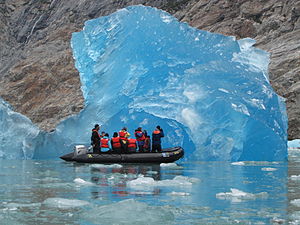
A blue iceberg is visible after the ice from above the water melts, causing the smooth portion of ice from below the water to overturn. [1] [2] The rare blue ice is formed from the compression of pure snow, which then develops into glacial ice. [3] [4]
Contents
- Physics of light and color
- White icebergs
- Preferential light absorption and age
- Color spectrum and water
- RMS Titanic
- References
- Further reading
Icebergs may also appear blue due to light refraction and age. Older icebergs reveal vivid hues of green and blue, resulting from a high concentration of color, microorganisms, and compacted ice. [5] An iceberg of “electric blue” colour in the waters off Sermilik fjord near Greenland in 2009 was named by locals the "blue diamond". [6]
